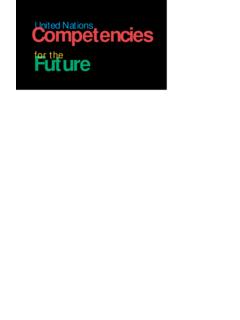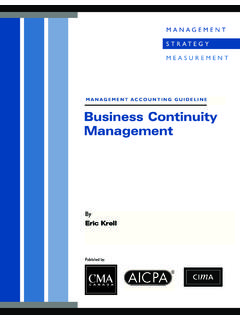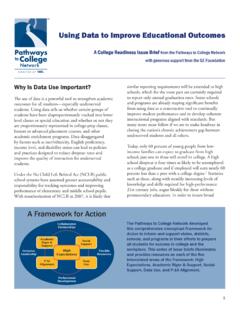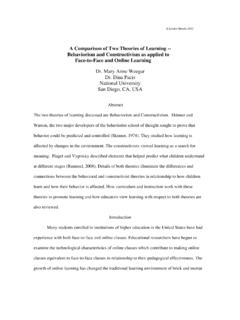Transcription of PUBLIC SECTOR LEADERSHIP FOR THE 21ST CENTURY: …
1 Copyright OECD 2001. All rights SECTOR LEADERSHIP FOR THE 21st CENTURY: EXECUTIVE SUMMARYL eadership development is neither new nor unique to the PUBLIC SECTOR . Why then has it become a hotissue? In general, OECD Member countries are finding that there is a gap between how their PUBLIC sectorsare, and how the interests of the nation need them to be now or in the future. Member countries are findingsomething missing between existing PUBLIC service cultures and the PUBLIC interest. A common complaint islack of dedication to the underlying values of PUBLIC service and the interests of the citizens served.
2 Acommon response seems to be the attempt to promote a certain kind of is a critical component of good PUBLIC governance, which is a major theme for current OECD work. Governance can be briefly described as the way in which the underlying values of a nation (usuallyarticulated in some way in its Constitution) are institutionalised . This has formal aspects such asseparated powers, checks and balances, means of transferring power, transparency, and , for these values to be actualised, they must guide the actions of PUBLIC officials throughout thesystem.
3 They must be imbedded in culture. In this regard LEADERSHIP is the flesh on the bones of theConstitution. It is at the heart of good most important role of PUBLIC SECTOR leaders has been to solve the problems and challenges faced in aspecific environment. When we say we want more LEADERSHIP in the PUBLIC SECTOR , what we are reallylooking for is people who will promote institutional adaptations in the PUBLIC interest. LEADERSHIP in thissense is not value neutral. It is a positive espousal of the need to promote certain fundamental values thatcan be called PUBLIC is an important and crucial variable that leads to enhanced management capacity, as well asorganisational performance.
4 A LEADERSHIP focus also plays an integrating role among various HumanResource Management components including recruitment and selection, training and development,performance management, PUBLIC service ethics, and succession LEADERSHIP development strategies of OECD Member countries, historically and culturally are spreadacross a wide spectrum. At one end is a high level of central intervention in which future leaders areidentified and nurtured from the early stage through a centralised selection, training and careermanagement process.
5 In contrast there is a growing group of countries which adopt market-type approaches to developing and securing leaders. Between these poles, there are different mixes of the twoapproaches. Many countries now have designated Senior Executive Services membership with varyingdegrees of central trends of LEADERSHIP development in OECD Member countries are: Developing comprehensive strategies: A few countries have set up systematic strategies forleadership development. For instance, the UK Government has recently started to work on aleadership development model.
6 The Norwegian Government has renewed its strategic planfor LEADERSHIP in the civil service, in order to reflect increased concern for PUBLIC OECD 2001. All rights Setting up new institutions for LEADERSHIP development: In some countries, like Sweden andthe US, governments have set up new institutions for identifying and developing futureleaders in the PUBLIC SECTOR . In Sweden, the National Council for Quality and Developmentwas created recently with the main task of identifying potential leaders.
7 Linking the existing management training to LEADERSHIP development: Many countries areexpanding their existing management development programmes to encompass leadershipdevelopment. One LEADERSHIP development programme in Finland includes the creation of anew management development programme following re-evaluation of their previous is no single best model for developing future leaders, because each country has its unique publicsector values to be emphasised and the management systems are different from country to country.
8 Despitethe diversity of strategies and approaches adopted by OECD Member countries, some general and commontrends in developing future leaders can be drawn from the country experiences. To define a competence profile for future leaders: In the UK and the US, the first step takento develop future leaders was to define the competence profile for future leaders. The ideaunderlying this is that competencies required for future leaders could be different from thoserequired for present leaders in terms of their responsibility, capability, and role.
9 For thisreason, it is essential to predict what forms the future PUBLIC SECTOR will take, and whatchallenges will be faced in order to identify and develop leaders suitable for the futureenvironment. To identify and select potential leaders: Given the competence framework for future leaders,the next step is often to identify and select potential future leaders. This issue involves thechoice of whether to select future leaders from outside or to nurture them within the publicsector.
10 If a country puts more emphasis on the former method rather than the latter, it shouldalso address the question of how to recruit the best and the brightest candidates incompeting with other sectors. To encourage mentoring and training: Once potential leaders are identified and selected, thenext step is to train them continuously. For this purpose, some countries set up a specialisedinstitution for LEADERSHIP development. Others put greater emphasis on LEADERSHIP in existingcurricula and establish new training courses for the top executives or senior managers.


















